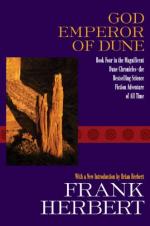|
This section contains 305 words (approx. 2 pages at 300 words per page) |

|
[The] fourth and apparently final episode in the Atreides saga, [God Emperor of Dune,] is a fatalistic, somber, typically complex creation which manifests something of the structure of a Bach fugue (a parallel which Herbert clearly intended). 3500 years have passed since the death of Paul Atreides and the accession of his son Leto II: the ecological transformation of Dune is complete, with crops, forests and seas obliterating the desert; the sandworms have vanished, ending "melange" (addictive geriatric spice) production; the God Emperor Leto broods in his citadel as he slowly metamorphoses into Shai-Hulud, the fearsome giant sandworm of old Dune. So now there's a dullish peace throughout the Empire, rigidly enforced by the Emperor's ruthless control of the remaining melange and his omniscient, oracular vision. But, while wise old royal majordomo Moneo is convinced of Leto's essentially benevolent intentions, embittered Siona (Moneo's daughter) and bewildered, reincarnated Duncan Idaho...
|
This section contains 305 words (approx. 2 pages at 300 words per page) |

|


